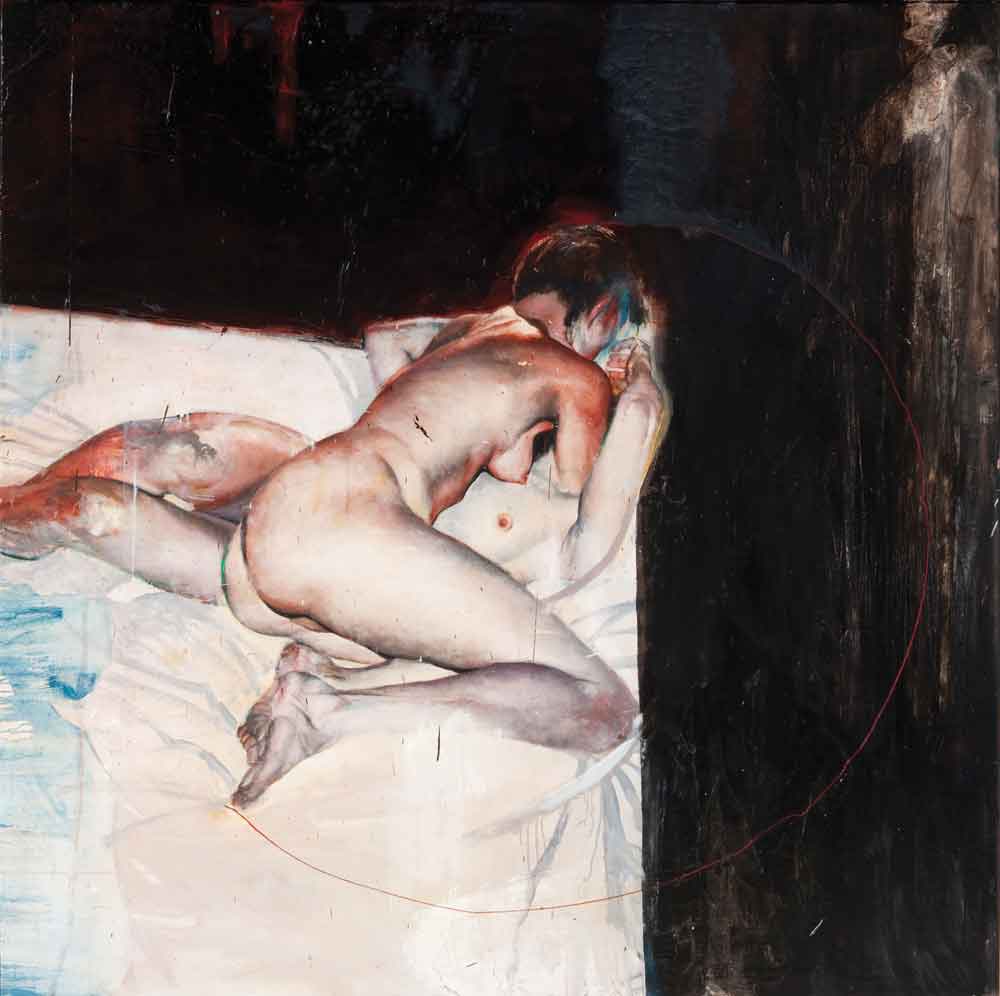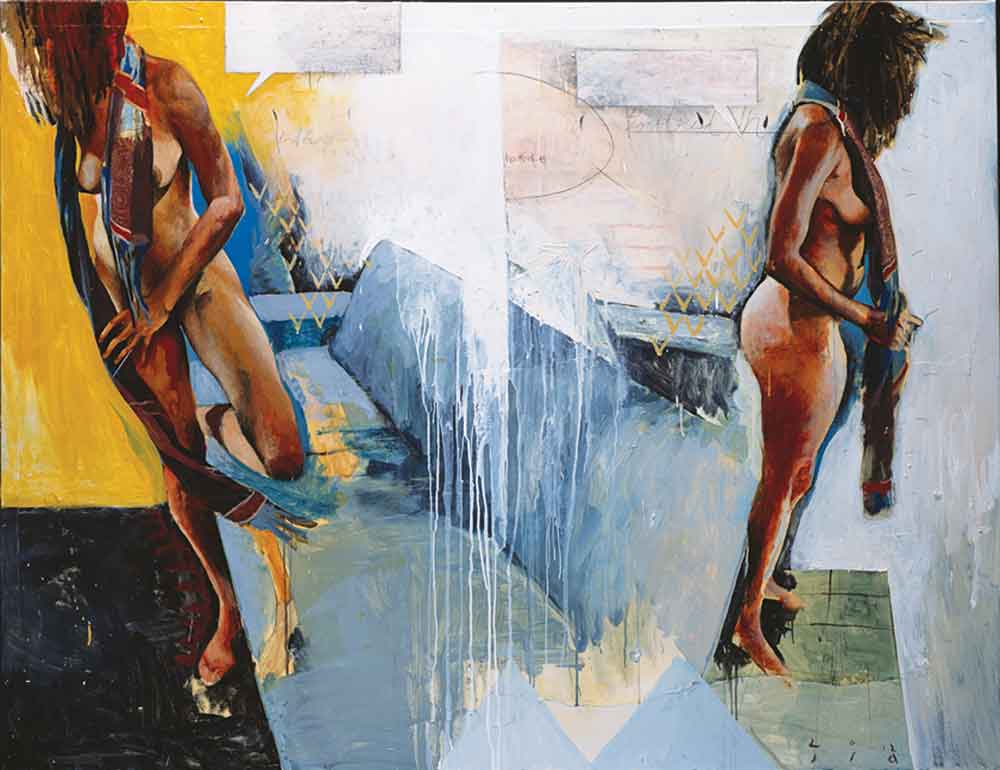« Reviews
Jason Shawn Alexander: {sic}
101/exbibit - Los Angeles
By Heike Dempster
An artist’s oeuvre represents the story of his life, evolution and process of exploration. The work of Jason Shawn Alexander has changed and moved to new, uncharted territory without a safety net. He has incorporated new techniques into his approach, and for the first time he displayed his two sides in one exhibition, showing his figurative paintings and graphic illustrations side by side.
Alexander’s paintings are intense while still displaying vulnerability, capturing deep human emotions. Each of his carefully chosen protagonists infuses the works with a dramatic narrative that Alexander translates onto the canvas, channeled through his own interpretation and informed by his relationship with each of them.
In his latest exhibition, “{sic}” at 101/exhibit in Los Angeles, Alexander presented a collection of large, narrative paintings and select graphic works. Each work is a story, a drama really, with its own truths, boundaries and narrative. The honesty and vulnerability Alexander conveys in his oeuvre are an outcome of the artist’s personal conversation with his work via his ability to confront fear and uncertainty. The artist lets go and surrenders himself completely to his paintings, merging himself and his personal life with his works.

Jason Shawn Alexander, The Lovers, 2012, mixed media collage, inks, oils, and paper on canvas, 60” x 60”. All images are courtesy of the artist and 101/exhibit, Los Angeles.
In Alexander’s words, “{sic}” is about “letting go while revealing emotional windows that disclose split-second vulnerability.” Meaning “as intended,” based on the literary term derived from the Latin adverb, {sic} is a fitting title that captures the essence of Alexander’s new works.
“{sic}” compares and contrasts Alexander’s roots in illustration with his evolution as a painter and his growth over the duration of his career. The paintings in the admired Alexander style, with added elements of brighter colors, found objects and abstractions, contrast with the illustrations on plain white background. The latter demonstrate the same drawing component as his graphic illustrations for comics such as Batman.
The illustrative works seem more defined and surrounded by less emotional turmoil. The stories are straightforward, with less context to absorb and less layers of intricate details to explore. By contrast, the illustrative works are more akin to short stories in a library with shelves filled with beautiful, epic novels of tragedy and drama. In these stripped-down renderings, Alexander’s tremendous skill with figurative drawing is showcased, and his knowledge and expert use of space is central. The drawings convey a sense of pensive serenity even with added sheet music, which visually fills the emptiness in some of the pieces and conceptually infuses the silence with a soundtrack.
The main focus of “{sic}” though are Alexander’s paintings, which are investigations captured on canvas. Each mistake, each seemingly misplaced brushstroke, represents an emotional scar, some of which, as in life, are more prominent than others. Many of the works in “{sic}” mark a departure from Alexander’s style seen in his prior exhibition “Undertow.” The paintings appear less refined and more focused on the process of exploration and experimentation than technical perfection. The departure includes technique as well as the representation of the protagonists and the emotions conveyed. Alexander uses a brighter color palette compared to older works, for the first time adding a sense of hope and warmth. He uses less waifish and emaciated bodies, suggesting a less emotionally twisted mindset and a more serene soul infusing his canvases with life.
Alexander explores how he wants to present his magnificently painted figures in a new and inventive way, incorporating found objects into his paintings, such as crime scene tape, comics and various polyurethane and synthetic materials, to set more complex scenes, while in his previous work the protagonist was the main and only focus amidst an abstract background. In his new work, the artist pushes himself even further into a space of uncertainty, expanding his own boundaries and exploring new depths. He leaves raw spots of canvas, suggesting openness, exposure and susceptibility. In addition to the emotions in Alexander’s figures, evident in the eyes, expressions, gestures, posture, color choice and use of light, the artist now uses the canvas-or, in one case, plywood-as more than just a blank surface. That surface is incorporated into the painting as a carrier of meaning, and so are the objects buried in the paint, at times partially visible and at times obscured until second or third glance.
Aspects of what previously defined Alexander’s work technically and aesthetically are still present in the work in “{sic}.” His ability to show energy and kinetic movement via the use of double imagery-showing multiple views, angles and expressions at once-lends an undeniable strength to the paintings. The emotions in these works range primarily from sad, strained, haunted, bewildered and intense to honest, pensive, exposed and as real as it gets.
The artist’s personal demons inform the paintings’ narratives, and changes in his personal life are quite evident in the work. “{sic}” demonstrates a happier Alexander in his self-portrait, as well as his depictions of his wife and the close friends who are part of his circle and who are the protagonists of the paintings. Noteworthy of the models’ appearance in the new work is a stronger presence of African-American men and women, such as his wife and actor Windell, who also marks a new page in Alexander’s book in terms of body type. Windell is a black, large, overweight man who stands in sharp contrast to the often skeletal or sinuous and muscular body types in the artist’s earlier works. Absent to a large degree is a look of sickness and despair. Even in the works that strongly resemble paintings in “Undertow,” the desolate look and feel is accompanied by a sense of acceptance and willingness to face the darkness with strength and carry even the burden of eventual death.
The use of text is a prominent new feature in Alexander’s work. Words such as “chance,” “dig,” “solitaire” and the phrase “to the great egress” infuse the paintings with poetic resonance, adding yet another voice to the conversation. The often nude protagonists bare their souls and essence of their being to the viewer and speak clearly through body language and mimicry, and the text adds even more of the painter’s voice. Literally, the word or phrase can be interpreted by definition or in relation to the painting, but the text’s relevance goes beyond the dictionary. The texts’ locations, top center or bottom center, deliberately draw the viewer’s eyes to a certain place on the painting, guiding the eyes to a point of entry and creating an interaction with the protagonists.
“{sic}” presents Jason Shawn Alexander completely for the first time, combining the painter, illustrator and man into an exhibition that introduces the artist as intimately as he introduces his protagonists through his work. Alexander has stepped passed previous boundaries and explored new territory, taking risks, experimenting, and in the process evolving and finding new ways to express himself. The story goes on, and the haunted characters continue to fight their demons and live life, allowing Alexander to capture those glimpses of raw emotions with such power and strength that they translate beyond the canvas.
(October 13 - November 26, 2012)
Heike Dempster is a writer and radio host based in Miami and actively involved in the local art scene.
Filed Under: Reviews





































Leave a Reply
You must be logged in to post a comment.